Attached files
| file | filename |
|---|---|
| S-1/A - S-1/A - Help International, Inc | s102047_s1a.htm |
| EX-99.1 - EXHIBIT 99.1 - Help International, Inc | s102047_99-1.htm |
| EX-99.7 - EXHIBIT 99.7 - Help International, Inc | s102047_99-7.htm |
| EX-99.2 - EXHIBIT 99.2 - Help International, Inc | s102047_99-2.htm |
| EX-99.4 - EXHIBIT 99.4 - Help International, Inc | s102047_99-4.htm |
| EX-99.3 - EXHIBIT 99.3 - Help International, Inc | s102047_99-3.htm |
| EX-99.5 - EXHIBIT 99.5 - Help International, Inc | s102047_99-5.htm |
| EX-99.6 - EXHIBIT 99.6 - Help International, Inc | s102047_99-6.htm |
| EX-23.1 - EXHIBIT 23.1 - Help International, Inc | s102047_ex23-1.htm |
Exhibit 99.8
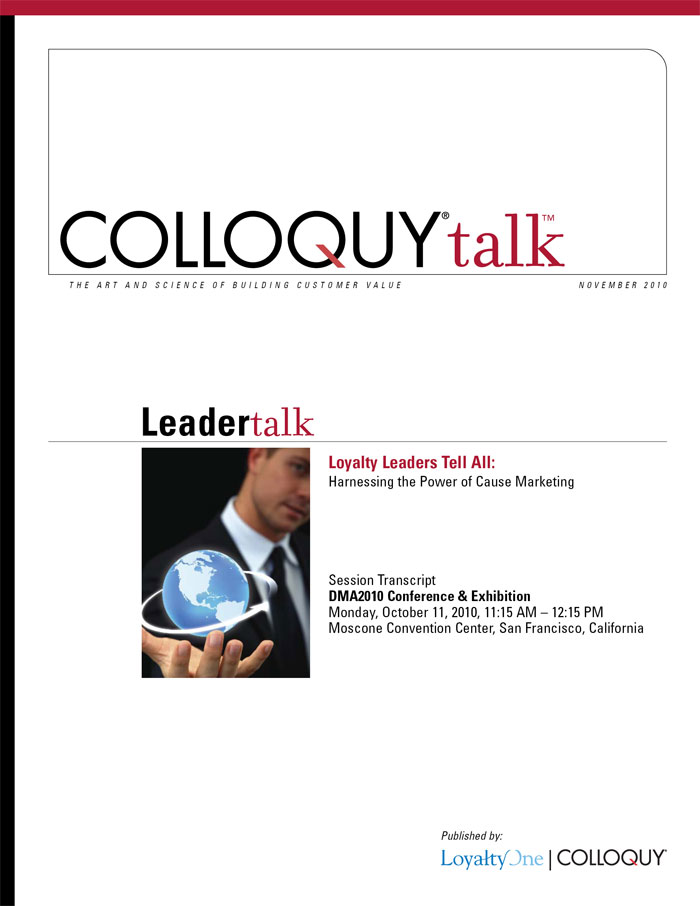
| COLLOQUYtalk / 11.10 | WWW.COLLOQUY.COM |
Loyalty Leaders Tell All:
H A R N E S S I N G T H E P O W E R O F C A U S E M A R K E T I N G
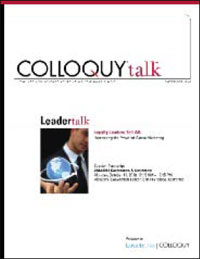
Introduction
In recent years, COLLOQUY has seen four trends taking hold—what we call the four C’s: Coalition or partnership marketing is taking off to new heights. Cooperative marketing—integrating social networking into your frequency or loyalty-marketing strategy. Customer-centricity and the burgeoning use of data beyond marketing-department applications. And then, of course, Cause marketing—thinking about how we can integrate causes that are crucial to our customers into the strategies that we deploy to cultivate deeper loyalty among our customers. After three decades of learning how we can influence customers’ purchasing decisions and reward and recognize them for making one more visit to our store or flying our airline one more time or making that extra purchase, loyalty marketers are now figuring out how that same discipline can be applied to affecting ethically and socially responsible behaviors to make the world a better place through relationships with loyal customers.
Those behaviors might be green—environmentally responsible actions. Or they might be pink—supporting breast cancer research and awareness. Whatever the color, whatever the cause, the trend toward cause marketing will become even more important as the time demands on consumers become even more intense and as the importance of local communities increases for those customers.
With that in mind, COLLOQUY gathered four leading loyalty- and cause-marketing experts who have figured out how to determine the causes that are right for their brands, and integrated them into their loyalty programs.
| PAGE 1 |
| COLLOQUYtalk / 11.10 | WWW.COLLOQUY.COM |
Introducing the Loyalty Leaders Panelists:
Morley Ivers. Corporate Advisor (formerly Chief Rewards Officer) at RecycleBank and Chief Operating Officer at Daily Feats. As Chief Rewards Officer, Morley had global responsibility for developing and executing the RecycleBank Rewards Program. Morley is the named co-inventor on three corporate patent applications for RecycleBank’s rewards model and his team was responsible for building and leveraging its consumer loyalty-marketing platform to increase recycling rates in more than 100 communities in the U.S. and several boroughs in the U.K. During his time with RecycleBank, the program grew to more than 3,000 reward partners. Morley recently accepted COLLOQUY’s 2010 Innovation in Loyalty Marketing award before announcing his formal transition from day-to-day operations with the company. His new business is DailyFeats, where he serves as COO. DailyFeats is at the nexus of “check-in” and “loyalty” and focuses on applying a rewards model to incent people to “Do Good and Check It In.” The DailyFeats model drives “Brand Behavior Affinity™” toward its partners who sponsor positive actions, known as “Feats,” within the program. DailyFeats’ beta program is now live and the company expects to launch with a national coalition program in early 2011.
Erin DeRuggiero, Co-Founder & CMO of Social Reality, a digital cause-marketing consultancy. Erin and her team deliver “real impact for brands marketing in the virtual world,” leveraging social media to launch never-before-seen cause-marketing programs. Prior to launching Social Reality, Erin was VP, Innovation & Digital Strategy for Gaiam Inc.’s Lime Network, where she spear-headed strategic partnerships for the Lime Network. She also spent nine years with Utne Reader magazine as National Advertising Director and she has consulted for Crocs, Sierra Magazine, NaturalPath Media, Tait Subler, Capsule Design and MusicMatters. Erin is participating in our panel on behalf of her client Seventh Generation.
Asha Patel, Manager of Dividend Miles Partnerships at US Airways. Asha is responsible for managing over 32 airline partnerships that generate in excess of $50MM in program revenue. She is the face of US Airways in Star Alliance and manages all aspects of the domestic and international frequent-flyer partnerships. Asha has spent the last five years in a variety of management and loyalty-related positions for US Airways. Prior to US Airways, Asha held positions in sales and finance at Williams-Sonoma and CSK Auto. She is an Architect by training and has an MBA from the University of Canberra, Australia.
Candice Troupe, Senior Director of Marketing for LoyaltyOne and the AIR MILES Reward Program in Canada. Candice has more than a decade of customer segmentation and marketing experience. She ensures that LoyaltyOne’s AIR MILES Reward Program’s more than 10 million collectors receive the right offers at the right moment with relevant, one-to-one targeting. Candice directs overall collector strategy, life cycling, retention and migration for the Gold program, the AIR MILES for Business program, and the My Planet program. Further, Candice is responsible for acquiring and on-boarding new collectors and guiding them through the life cycles of their plans. Prior to joining LoyaltyOne in 2001, Candice worked for Playdium Entertainment, Toronto, as senior manager of loyalty, and at Consumers’ Gas Co., the Toronto utility, as supervisor of direct marketing. She also held a previous post at LoyaltyOne for two years, as manager of the Gold and statementing programs.
Moderator: Kelly Hlavinka, Managing Partner, COLLOQUY. Kelly has helped define and carry out COLLOQUY’s mission as the voice of the loyalty industry since 1996, Drawing on her 20 years as a loyalty specialist, Kelly develops articles, white papers and educational initiatives that illuminate the many ways to unlock the asset of customer-specific data for her clients. Kelly has shared her expertise with correspondents of The Wall Street Journal, The New York Times, USAToday, Brandweek, BusinessWeek, Advertising Age and SmartMoney. She has taught loyalty-marketing workshops and webinars around the world. In 2003, Kelly launched and managed COLLOQUY’s strategic consultancy, working with clients such as Lennar Homes, MGM MIRAGE, Eddie Bauer, Best Buy, HP and American Express. Her prior experience includes positions managing membership programs with Buyers Choice (now The Polk Co.) and the National Wildlife Federation, and she has held database-marketing positions with ACS and Equifax Consumer Direct.
| PAGE 2 |
| COLLOQUYtalk / 11.10 | WWW.COLLOQUY.COM |
| “In Canada, consumers have a number of causes they care about—health, education, kids and ‘green.’ We knew that whatever cause we chose, it had to be one of those four to be as relevant as possible to our collectors.” |
| CANDICE TROUPE |
I. Why Choose This Cause?
Kelly Hlavinka, Moderator: Morley, let’s start our discussion with you. You’ve invested a good portion of your career in cause-related loyalty. Can give us an overview of RecycleBank, and how it works? And, how does that compare to your latest endeavor at DailyFeats?
Morley Ivers, RecycleBank/DailyFeats: I joined RecycleBank to create a rewards program that motivates individual consumers to increase their recycling rates. We have a proprietary technology that allows us to weigh individuals’ recycling as it is dumped into the truck, and to award points based on the weight. We are servicing more than 100 communities in the United States and five boroughs in the United Kingdom. We have more than 3,000 reward partners who want to associate themselves with improving the environment. The net result: We’re dramatically increasing recycle rates in nearly every city we’re in.
I joined DailyFeats when the founder offered the opportunity to help create a rewards program at the nexus of check-in and loyalty that incents individuals for positive behaviors across a wide spectrum of consumer actions. A coalition of partner brands like 1-800-Flowers.com sponsor Feats and Rewards for various positive consumer actions—everything from health and fitness to wellness and every other type of good action. It’s a pay-it-forward rewards model that is designed to make the world a better place.
Hlavinka: Erin, the mission of Seventh Generation and the environmentally responsible cleaning and household products they produce is also centered around helping the environment. What was the catalyst for introducing the Seventh Generation Nation program in 2008? And what are the benefits for the customer?
Erin DeRuggiero, Social Reality/Seventh Generation: Two and half years ago Seventh Generation Nation was started in response to people coming to the company saying,”I want a better understanding of how my purchase really impacts the environment.” So Seventh Generation developed a community to answer that and other questions like it. Seventh Generation Nation gives consumers access to a panel of experts such as Martin “Scienceman” Wolf or Dr. Alan Greene, an amazing author and physician, who answers such questions as “Why is it important to green my nursery?” The company can also tap into its research panel of 400,000 members who have signed on and serve as experts themselves. When Seventh Generation wants to roll out new products, the company engages the panel in the process to get their feedback and learn how to make products better and more relevant. Also, members have access to blogs and forums, which is a way to reach out and communicate about Seventh Generation’s different non-profit partners, such as the Ovarian Cancer Research Fund or Healthy Child Healthy World. The company has a really engaged, loyal and passionate base of people who are moving that message forward, and they can get involved in the community with various projects that have Seventh Generation as a partner. And they have access to coupons and special offers and other important things through the Nation.
Hlavinka: Candice, the AIR MILES loyalty coalition is the dominant loyalty program in Canada, allowing collectors to earn rewards by shopping with a wide range of sponsor partners. Tell us about how the My Planet initiative works within the context of the broader AIR MILES program?
Candice Troupe, LoyaltyOne/AIR MILES: My Planet is the AIR MILES reward program’s cause-marketing initiative focused on helping consumers and our retailers make smart environmental choices. Because we are a coalition program with 120 retail partners and two-thirds of Canadian households, we knew going into the initiative that we had critical mass. Our CEO, Bryan Pearson, is absolutely passionate about cause marketing and particularly about “green.” But our path to this particular cause was also founded on data. In Canada, consumers have a number of causes they care about—health, education, kids and green. We knew that whatever cause we chose, it had to be one of those four to be as relevant as possible to our collectors. We went out to our collectors and asked, “Of those four causes, which do you think we can make the most impact on? Which makes the most sense for our brand, and which is the one that you want us to pay attention to?” Green came back as the top choice.
| PAGE 3 |
| COLLOQUYtalk / 11.10 | WWW.COLLOQUY.COM |
| “We looked at our passengers and what they do on our planes, and saw that most of them read. So in choosing a cause that would engage our employees and our members, and that would be something everyone can identify with, we picked Reading Is Fundamental, a non-profit organization that focuses on creating kids’ awareness about reading.” |
| ASHA PATEL |
We know our collectors, we know what they’re shopping for, we know their lifestyle choices, we know what life stage they’re at. That data confirmed that green is a cause that would be relevant to the majority, but then we saw that between one and three million of our more than 10 million collectors felt very strongly about this cause. We built the program to be relevant to the entire base, with the focus on those really passionate collectors. And with those collectors, we had a base not only of early adopters who could get the word out, but also of consumers engaging in conversation with us to help us understand what we could do next.
In fall 2009, we launched My Planet with three tenets: First is the earn component in which collectors earn incremental miles for making environmentally responsible purchases from our sponsors—which are identified with shelf-talkers and so on at the retail locations. The burn component includes redemption of environmentally friendly products, such as organics and energy-efficient appliances, from our rewards portfolio. The learn component features an educational web portal that helps our collectors understand how to make environmentally sustainable decisions.
Hlavinka: Asha, in contrast to the others on our panel, US Airways has integrated cause marketing with your loyalty strategy in a different way—and for very different types of causes, including the Reading Is Fundamental program. Why is Reading Is Fundamental the right platform for US Airways?
Asha Patel, US Airways: As the fifth-largest airline in the United States, US Airways has more than 30,000 employees. A couple of years ago as a company we asked, “How can we pick a cause that would be relevant?” We looked at our passengers and what they do on our planes, and saw that most of them read. So in choosing a cause that would engage our employees and our members, and that would be something everyone can identify with, we picked Reading Is Fundamental, a non-profit organization that focuses on creating kids’ awareness about reading. It’s a program with a national/global footprint that allows employees and customers of US Airways to join in, regardless of language, culture, and so on. Our members are passionate about literacy, and this allows US to align corporate goals with the goals and values of our members.
We launched the RIF Read with Kids Challenge in 2008, creating and printing 300,000 books featuring Maisy the Mouse from a popular children’s book series by Lucy Cousins, and putting them in every seatback on our planes. Passengers were welcome to read to their children on the plane, and take home the books, as well. They were encouraged to log on to the RIF.org website, register, and log “reading minutes” every day that they read to a child. Rewards for that activity include US Airways vacation packages, travel gift cards, and other prizes. Members also receive Dividend Miles and a free children’s book for making monetary donations. When we launched the program, our goal was one million reading minutes, and by the end of the year we reached four million minutes. The following year our goal was five million reading minutes and we hit 10 million. This year we’ve already surpassed our goal of 10 million reading minutes.
US Airways has another cause-marketing platform that’s been integrated with our frequent-flyer program. In 1998, we launched Miles of Hope, an ongoing program that allows our Dividend Miles frequent-flyer members to donate their miles to one of four national non-profit organizations: Red Cross, Mercy Medical Airlift, Fisher House Foundation, and Make-A-Wish Foundation. The program is ongoing, but during the holiday season we run special promotions in which US Airways donates 1,000 miles for each 5,000 donated by members. Donated miles are used to fulfill each organization’s mission—they redeem for flights, for instance, to transport their personnel to natural calamities. To date, more than 700,000,000 miles have been donated, which equates to more than 15,000 flights. This is a great way for our customers to donate miles, keep their accounts active and continue to earn more miles.
| PAGE 4 |
| COLLOQUYtalk / 11.10 | WWW.COLLOQUY.COM |
“Children and environmental health—those are at the core of the mission and the name of the company [Seventh Generation], which is taken from an Iroquois saying regarding being conscious about the impact you have not only for this generation but for the next seven generations.”
ERIN DeRUGGIERO |
||
II: Role of Content/Education in Engaging Members
Hlavinka: Candice, you mentioned that the learn component is a core pillar of the My Planet platform within AIR MILES. What role does content play in engaging collectors and in generating support for the environment and AIR MILES overall?
Troupe: Our content objective is two-fold. The first is to educate consumers on green or sustainable choices. We heard from Canadians that a ton of content about the environment is coming at them, and some of it is contradictory. Also, given the generally busy lives of most people, it’s really difficult to glean through all that content and understand what they can do day-to-day to help the environment. Our first objective was to make the content simple and bring credibility to it. We have done that through our website design, through our existing content-publisher partnerships, and through working with organizations like the World Wildlife Fund [WWF]. They are credible organizations within the environmental space.
Our second objective is to use content as a trigger to create conversation and community among our members—so they can talk about the environment and give each other tips and tricks and advice on how to make a difference. In doing so, we found that our brand gets credit for being a good corporate citizen caring for this cause, and that the members’ level of engagement with each other drives a significant amount of activity.
We launched My Planet a year ago and a third of those who visit our website are spending time on the My Planet pages. But what’s most exciting for us is the conversation about the environment going on in the community part of the website. It’s not about My Planet—it’s about the environment. And that’s encouraging for us.
Hlavinka: Erin, Seventh Generation Nation offers members a lot of content-based advice, as well. You’ve also built upon that with some interesting social-media campaigns. What kind of engagement rates have you seen with the content and with the campaigns?
DeRuggiero: What’s most important for Seventh Generation truly isn’t to get eight million people to sign up for a program or to download a coupon. What they’re really interested in is the most engaged, passionate ambassadors for the brand. So they rolled out a program called Million Baby Crawl. The company tapped the Seventh Generation Nation members to create a virtual crawler that would raise the awareness around the Kids Health and Safety Act of 2009. It was all about trying to gain tougher legislation around toxicity in household products. Of the 400,000 Nation members, around 25,000 signed on to create the virtual crawlers. Those 25,000 people were really influential and they had about 100,000 of their friends sign on with messages of support. That was really powerful, really successful. They are telling their friends and they are posting it on Facebook and tweeting about it. That’s the way the company will encourage people to engage—through this personal connection with people they trust.
Hlavinka: For those who aren’t familiar with Seventh Generation’s products, why did the company choose the “million baby” theme?
DeRuggiero: Seventh Generation wouldn’t align with a cause that wasn’t closely aligned with children and environmental health—those are at the core of the mission and the name of the company, which is taken from an Iroquois saying regarding being conscious about the impact you have not only for this generation but for the next seven generations. So starting with our children is the most important aspect. The company wants to create healthy generations from here on out. Baby products and baby health are at the core of Seventh Generation.
Hlavinka: RecycleBank has similar content and educational features. How have those features played in overall participation rates you have seen among your members?
Ivers: Content is very important to the RecycleBank business model. We want to make a difference in the world and the best way to do that is to get people to come to our site and spend time with us. While on the site, RecycleBank rewards members for learning about better environmental choices.
| PAGE 5 |
| COLLOQUYtalk / 11.10 | WWW.COLLOQUY.COM |
“Content becomes most engaging when it’s not created by the organization itself but by the members who drive the word-of-mouth propagation and become ambassadors . . . for the brand. So, providing members with the ability to come up with their own suggestions and have their voices heard, and then allow our partner brands to support the actions is what DailyFeats is about.”
MORLEY IVERS |
||
For example, if a member goes to the site and learns that the more environmentally preferred choice is to use a dishwasher rather than washing dishes by hand, he or she earns points. And we would allow a brand like Seventh Generation to sponsor rewards in the program—to associate itself with that type of content and education.
The business model benefits because people coming to our site to learn about that choice between the dishwasher and doing dishes by hand drives the time on site up, drives the engagement rates up, and allows us to monetize our site in different ways.
With DailyFeats, we have more than 150 curated Feats for people to take positive actions and to learn about different ways to better themselves, their world and the lives of people in their social networks. And then we allow brands to get involved. So, content matched with loyalty is an absolute must in terms of executing profitability.
Hlavinka: You’re also talking about rewarding members on the site for watching and reading and even creating content. Is that an area that RecycleBank and DailyFeats are thinking about extending as well?
Ivers: Right. Content becomes most engaging when it’s not created by the organization itself but by the members who drive the word-of-mouth propagation and become ambassadors, as Erin said, for the brand. So, providing members with the ability to come up with their own suggestions and have their voices heard, and then allow our partner brands to support the actions, is what DailyFeats is about for a wide spectrum of positive member actions and what RecycleBank does from an environmental perspective. We’ve found great success. It’s a bit of a snowball effect in that members build the content for your site and that drives engagement rates up.
| PAGE 6 |
| COLLOQUYtalk / 11.10 | WWW.COLLOQUY.COM |
“We have started to really think about how we can integrate cause marketing into everything we do—at least from a major program perspective. So for all of our major marketing promotions, we include a cause-marketing element.”
CANDICE TROUPE |
||
III: Ongoing Cause Versus the Big Disasters We Never Want to See
Hlavinka: Asha, at COLLOQUY, we’ve seen mixed results with some cause-related redemption options. In some cases, an ongoing redemption option provides a feel-good option that customers say they like to have; yet, redemption rates can prove to be somewhat low. On the other hand, when a disaster occurs, the member support in the form of redemptions to support relief can be phenomenal. Have you witnessed the same dynamic, or is it different among your members?
Patel: We actively promote Miles of Hope as a year-long initiative. We see greater activity during periods such as Thanksgiving and Christmas which also coincide with the time period in which the airline matches mileage contributions. We did see greater activity during big disaster periods such as the earthquake in Haiti and Chile but the redemption rates are on par with our typical redemption rates during holiday periods.
Hlavinka: US Airways also takes a somewhat different approach to events like the Haiti earthquake. Talk a little bit about that, because it’s core to your brand.
Patel: When there is a calamity, we as an airline do whatever we can to help, if a US Airways flight can have any kind of impact. We will fly family members anywhere to be with their families for support. We fly our employees over. We immediately deploy trained support employees experienced in helping people deal with tragedies.
Hlavinka: Candice, what has been your experience within the AIR MILES program with regard to collector donations for disaster relief and times of crisis?
Troupe: We’ve had fairly good success. After the Tsunami, we had collectors calling the AIR MILES office asking what they could do with their AIR MILES to contribute. I’ll be honest and tell you that we weren’t ready for it. So we quickly created a solution through our call center and website offering collectors the opportunity to donate miles to the Canadian Red Cross. We have since modified that capability for other disasters like the earthquake in Haiti. We allowed collectors to donate 200 miles for $25 to the Canadian Red Cross. In a month, we had $500,000 worth of donations. It was an amazing rallying point for our collectors.
We have started to really think about how we can integrate cause marketing into everything we do—at least from a major program perspective. So for all of our major marketing promotions, we include a cause-marketing element. For example, each fall we do a promotion called Free Gas and Groceries. Collectors using their cards have the opportunity to win free gas and groceries for life, and along the way, they have the chance to win $10 gift certificates, $20 gift certificates, and so on. We now offer the option of donating those miles to a charity or to a cause like WWF, Kids Help Phone, and three or four others. And we are seeing amazing success. I think that’s driven out of the fact that people want to help a cause but it’s also in part due to the economy. It’s important and good for consumers to help and give back in a meaningful way without having to break the bank or take money out of their budgets.
Our retail brands also recognize that our currency can make a big difference as it relates to their own cause-marketing efforts. If a collector goes to a retail location that offers AIR MILES, the retailer might provide the option for members to donate points to a particular cause. What we see is sort of a domino effect and it’s truly becoming integrated in all we do.
Hlavinka: Morley, there has been a lot of talk about the environment recently with the Gulf of Mexico oil disaster. Have you seen any uptick in engagement or enrollment rates or any other metrics that suggest that environmental disasters make an impact on your business?
| PAGE 7 |
| COLLOQUYtalk / 11.10 | WWW.COLLOQUY.COM |
“What I see in terms of reaching even higher levels of engagement is related to driving change en masse—not just related to the environmental actions but also to positive activities in literally every lifestyle vertical.”
MORLEY IVERS |
||
Ivers: With RecycleBank, because of the nature of the program and the frequency of earn—people recycle every day; they get new points either on a weekly or biweekly basis depending on their city’s pick-up schedule—the engagement rates are always very high. That’s directly tied to the fact that there’s a cause involved. And when I say “very high,” I mean when we roll out to a city every single household in the entire city may become a member of our program. But not every single person has to opt in and go to our website. In Cherry Hill, New Jersey, for example, where we have been deployed for over a year, we see upwards of 90% opt-in rates for our program. And a third of the households will redeem for rewards every month. What I see in terms of reaching even higher levels of engagement is related to driving change en masse—not just related to the environmental actions but also to positive activities in literally every lifestyle vertical—that’s the focus for DailyFeats and I expect that we will recognize a sustained level of engagement which presents marketing opportunities for brands to drive positive change and to pay it forward like never before.
| PAGE 8 |
| COLLOQUYtalk / 11.10 | WWW.COLLOQUY.COM |
| “We have 18 million members. We have connected the dots between US Airways and Reading Is Fundamental and we actively use our database to send communications to our members, educating them about the campaign—what we’re doing and why we want to raise awareness.” |
| ASHA PATEL |
IV. How Data Helps Engage Members
Hlavinka: Erin, one of the things we love about the Seventh Generation Nation site is the profile form that members complete regarding who they are, why they’re engaging with the program, and their shades of green. How is that data helping to engage customers more deeply into the program?
DeRuggiero: When you fill out your profile, you can say that you’re a light green, a medium green, or a dark green. Light green means you are just coming into the category, you are kind of eco curious, or you are thinking about purchasing products because it has the direct impact on the environment, but you’re not really sure what that impact is. If you’re medium green, you are somebody who really looks at the labels and you’re conscious about the purchase and who you buy it from. So maybe you are a little bit more mindful but not completely new to the category. Dark green people are the real ambassadors—people who really understand the connection between what they do and how it affects the planet. The information Seventh Generation gathers helps us in communicating and messaging.
Hlavinka: Morley, considering RecycleBank has been in market for a few years, please talk about your approach to member profiles and the data you use on the site, including using some techniques that many of us are familiar with within the context of more traditional loyalty strategies. How are you using this online communication?
Ivers: Though RecycleBank is different in that we’re driving loyalty towards a cause and towards our partners versus loyalty towards RecycleBank, we are traditional in terms of building our member profiles based on information from when they enrolled and on interests based on their past redemptions. As I mentioned before, RecycleBank has more than 3,000 different reward partners—organizations sponsoring rewards into the program—so people can redeem the points they earn by recycling for those rewards and drive business and loyalty towards those partners. Based on member profiles, we can actually curate the rewards specific to the consumer based on who they are, where they live, how often they shop—because, to recycle, you have to have purchased products. In essence, that’s what’s driven brands like Coca-Cola, Procter & Gamble, Kraft, Seventh Generation, and many other top firms to use RecycleBank as a green marketing platform to reach out with targeted communications to those consumers.
Troupe: We have 19 years’ worth of consumer data, and we’re in a bit of a similar space in that we’re trying to work closely with our retailers—our partner brands—to help them understand who is consuming green product, who is willing to buy a good product, and who has the propensity to do that.
Patel: We have 18 million members. We have connected the dots between US Airways and Reading Is Fundamental and we actively use our database to send communications to our members, educating them about the campaign—what we’re doing and why we want to raise awareness. We have had online banners, tents at the check-in counters, and books at the airport lounges. These are ways we use our database for this particular cause.
| PAGE 9 |
| COLLOQUYtalk / 11.10 | WWW.COLLOQUY.COM |
| “Another example of a grass-roots approach is a program called Card Lab Connect by Capital One that allows members to design cards for their own 501(c)(3) causes. It could be a Boy Scout troop or a local PTA.” |
| KELLY HLAVINKA |
V. Non-Profits Versus Corporations: Who’s After Who?
Audience Question: I’m curious about the interaction between non-profit groups or causes and other brands. Is it always one-sided where the brands are searching and vetting a non-profit cause that they want to support, or are non-profit organizations reaching out to brands, as well?
Troupe: We have been building off My Planet’s success and focusing more broadly on other social-change initiatives. World Wildlife Fund approached us regarding how we how we might work together, and how we could make a bigger impact. So we’re working closely with them now to develop a variety of programs and initiatives to drive activity. It’s a start, but clearly the work that we have done in the green space through My Planet was enough for WWF to reach out to us.
Hlavinka: AIR MILES is now partnering with some of the provincial governments as well to help with some of the things they’re trying to do.
Troupe: A number of Canadian government bodies, primarily on a provincial basis, have been trying to change green behavior over the last number of years. They generally have pretty big advertising budgets, but whatever incentives they’ve been using have not been working as successfully as they hoped. They understand, however, that the AIR MILES currency has the ability to change behavior. So we ran a series of tests and programs over the last six months. One was with the Ontario Power Authority, which is a government body trying to get Canadians to be more energy efficient in their homes. They’re trying to encourage people to turn off their lights, replace their inefficient appliances with more efficient ones, etc. And they are using a variety of incentives to get Canadians to take what they call a power pledge. The program we ran with them using the AIR MILES currency to get people to take the pledge started at the beginning of this year and ended in August. It had a considerable increase in results. So they are absolutely over the top about this, and we are now working with other provincial authorities to run similar programs across Canada.
One such program is with the Toronto Transit Commission [TTC]—subways, buses, and street cars within the City of Toronto. They have been trying for years to get Canadians to buy the monthly transit pass because pass-holders are less likely to drive to work each day. Again, the TTC was unable to find an incentive or pull together a campaign that has succeeded in changing that behavior. We ran a program for September metro passes and had a strong increase in adoption rates. So there’s lots of conversation now among government agencies around the power of the AIR MILES currency to change behavior.
DeRuggiero: In addition to working with Seventh Generation, our company works with Causes, a Facebook application that allows people to develop cause around an issue and then tie it to a non-profit. We work with brands to figure out the non-profit that makes the most sense for them. So we see it both ways, actually: We see brands looking for the right fit on the non-profit side and non-profits are coming to us asking if we can help them find a good fit based on what they do, their core missions, and what they can do for the brands.
Ivers: I have seen the highest levels of engagement rates come when we give the members choice as to where to direct their donations. With RecycleBank, for example, we partnered with a third-party organization that allowed members to donate their points to any 501(c)(3) IRS nonprofit organization. We curtailed that back just recently and our folks are doing our own proprietary cause called the RecycleBank Green Schools program.
With DailyFeats, our intention is to offer members a choice. That is what drives engagement rates up and removes the complexity that underlies your question, which is, “Does my company select one, two, three, four, five organizations members can donate to?” The answer is to offer them all and let your consumer choose. That way you are not saying “no” to anyone—you’re saying “yes” to everyone.
Hlavinka: That’s a great example of momentum coming from the grassroots. Another example of a grassroots approach is a program called Card Lab Connect by Capital One that allows members to design cards for their own 501(c)(3) causes. It could be a Boy Scout troop or a local PTA.
| PAGE 10 |
| COLLOQUYtalk / 11.10 | WWW.COLLOQUY.COM |
“Consumers today are more and more savvy. They can read between the lines and if something comes across as authentic and genuine, they’re able to see that. If it’s not authentic, then consumers will see that, too. It’s great that companies are supporting causes and donating more and more money. But it must be at the core of what you are doing, and that’s not just a campaign, it’s a mission.” |
ERIN DeRUGGIERO |
VI. Is There a Cause for Every Program?
Audience Question: Is it right for every loyalty program to be connected with a cause?
Ivers: Any loyalty program today that doesn’t have some aspect of cause-related marketing—some aspect relative to bigger audiences—is behind the times. The days of brands going out into the marketplace without recognizing that consumers want to patronize brands that are doing more than just selling products and services are over. We’re at a point when this is no longer an option. It’s a fact of life—the way that we’re doing things moving forward—and frankly, it’s a wonderful thing.
Troupe: I agree that it’s the standard—it’s not an option. But the trick is in the execution. It must be useful to your customers so it will resonate with them and matter to them. They must be able to participate in a relatively simple way—a way that doesn’t become a whole lot of work. We have the data to help us determine the right cause. The key is to walk the talk, to pick something that your organization believes in and can practice. It will not only engage your consumers, it will engage and create energy for your employee base as well. At AIR MILES, we turned our view inward when we chose green. We asked what we can do in our organization to be more environmentally friendly. Our lunchrooms have four different garbage cans labeled organics, biodegradables, recyclables, and regular garbage. We are practicing what we preach in everything we do.
Patel: You must understand what your member values, and then take what you believe in as a corporation and create synergies between the two. That’s why Reading Is Fundamental has been successful for us. Whether you’re an employee, whether you’re a parent, everyone understands the importance of reading.
DeRuggiero: A cause-related element needs to be authentic for you, it needs to be the right choice for the brand, and it needs to be the right choice for your consumer. So if it comes from an authentic place, it’s always going to be right.
Ivers: If you are not authentic you are going to fail.
Hlavinka: As all of you have said, we’re at an inflection point where it’s more important than ever to have some element of cause marketing invested with our very best customers. We want them to be loyal to us. But as more companies follow your lead and start to support causes by integrating them with their loyalty strategies, are we creating a paradox in which our efforts are great for the cause but are actually taking away some of the differentiation that we may have in the marketplace?
DeRuggiero: Consumers today are more and more savvy. They can read between the lines and if something comes across as authentic and genuine, they’re able to see that. If it’s not authentic, then consumers will see that, too. It’s great that companies are supporting causes and donating more and more money. But it must be at the core of what you are doing, and that’s not just a campaign, it’s a mission.
Ivers: I agree that consumers are savvy and that is what has led to the majority of failed reward programs—be it that consumers are only active in six out of the 14 programs that the average U.S. American is a member of. This upcoming paradox keeps me up at night. It forces us as practitioners of loyalty to ensure that at the very heart of our business is an awesome loyalty program—an incredibly dynamic platform that engages people and allows us to do well for our authentic cause.

| PAGE 11 |

Engage
Your Customers
Throughout the Loyalty Lifecycle
The key to deeper customer engagement is delivering personalized, relevant, timely, and actionable communications at every stage of the customer lifecycle.
By leveraging SoundBite’s Loyalty Rewards Program Solution, you can quickly and effectively communicate with your program members across a variety of devices and communications channels. The result? A substantial lift in redemption rates and incremental revenue, and improved customer relationships.
| www.soundbite.com/loyalty |  |
T H E P U B L I S H E R
| PARTNERtalk / 1.11 | WWW.COLLOQUY.COM |
For
more COLLOQUY white papers and studies,
visit www.colloquy.com/whitepapers
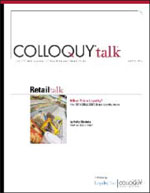 |
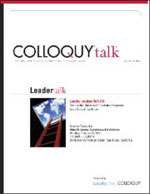 |
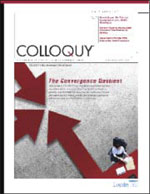 |
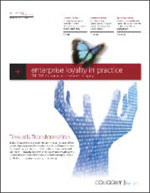 |
The Publisher
COLLOQUY® comprises a collection of publishing, education and research resources devoted to the global loyalty-marketing industry. COLLOQUY has served the loyalty-marketing industry since 1990 with more than 40,000 global subscribers to its magazine, and www.colloquy.com is the most comprehensive loyalty web site in the world. COLLOQUY’s research division develops consumer and B2B research studies and white papers including industry-specific reports, sizing studies and insights into the drivers of consumer behavior. COLLOQUY also provides educational services through workshops, webinars and speeches at events throughout the world and is the official loyalty-marketing partner of both the Direct Marketing Association and the Canadian Marketing Association. COLLOQUY also operates The COLLOQUY Network, a global consortium of practitioners certified in COLLOQUY’s proprietary methodology. COLLOQUY magazine subscriptions are available at no cost to qualified persons at www.colloquy.com or by calling 513.248.9184.
COLLOQUY also publishes Enterprise Loyalty in Practice, a semi-annual executive journal that gathers practical, innovative thinking from successful Enterprise Loyalty pioneers—practitioners and researchers who are building solid strategies for organization-wide customer focus. Subscriptions are $99 for two years; for more information, visit www.colloquy.com/EnterpriseLoyalty.
COLLOQUY is owned by LoyaltyOne (formerly Alliance Data Loyalty Services), which works with more than 100 of North America’s leading brands in the retail, financial services, grocery, petroleum retail, travel, and hospitality industries to profitably change customer behavior. Through a team of businesses, each specializing in a loyalty discipline, LoyaltyOne designs, delivers, and manages a suite of loyalty marketing services—consumer data, customer-centric retail strategies, direct-to-consumer marketing, loyalty consulting, and more. In addition to COLLOQUY, the companies include:
| · | LoyaltyOne Consulting is comprised of a group of internationally-recognized practitioners who design and implement loyalty-marketing strategies for Fortune 1000 clients. |
| · | The AIR MILES® Reward Program is Canada’s premier coalition loyalty program. More than 10 million active Collector accounts, representing approximately two-thirds of all Canadian households, actively participate in the Program. |
| · | Direct Antidote is a loyalty-marketing agency specializing in data-driven creative campaigns that transform customer behavior to deliver on short-term return on investment, while building profitable relationships for life. |
| · | Precima is a consulting and analytical services firm that uses shopper insights to enable more profitable merchandising and marketing decisions. Precima’s combination of loyalty, analytics and retail industry expertise has been honed over 18 years. |
For more COLLOQUY white papers and studies, visit www.colloquy.com/whitepapers

| 4445 Lake Forest Dr., Cincinnati OH 45242
Telephone: +1.513.248.9184 Fax: +1.513.248.9184 Email: info@colloquy.com |
©2010 LoyaltyOne US, Inc. All rights reserved. Permission to reprint may be granted upon specific
request. COLLOQUY is a trademark of
Alliance Data Systems Corporation used under license by LoyaltyOne US, Inc., an Alliance Data Systems Company.
| PAGE 12 |
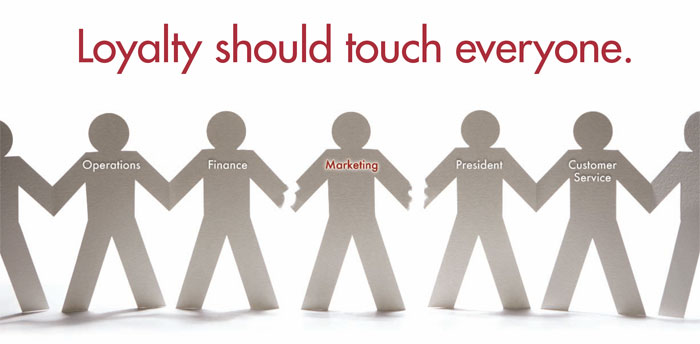
Enterprise Loyalty Day
Learn
how to build Loyalty across your organization
with the only full-day pre-conference intensive on
December 13 at the NCDM 2010 Conference.
For
more information,
visit www.NCDMevents.com

